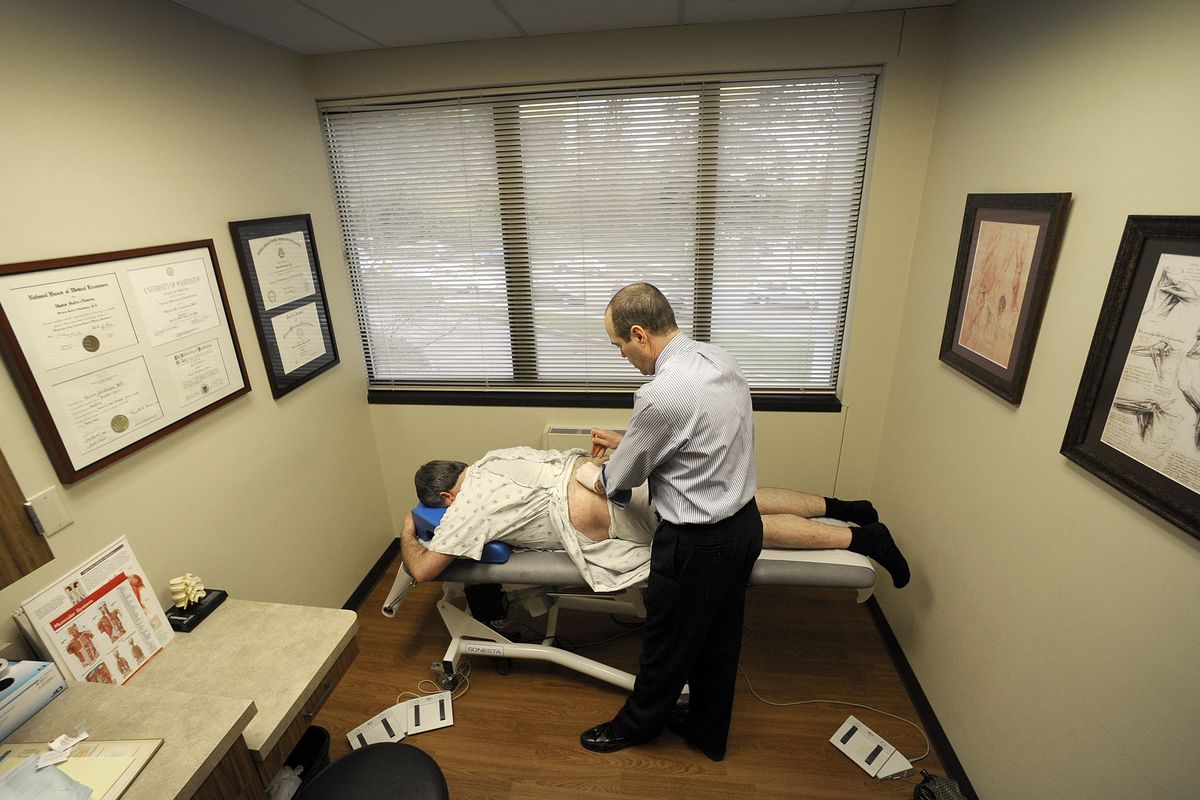Little-known intramuscular stimulation can offer pain relief

Faced with yet another back surgery, John Fisher remembers slumping in his chair, dispirited. “I guess I knew that’s what it would come to,” the Spokane man said. “And I knew that, eventually, my pain would return.”
It was the kind of hurt that dropped him to his knees. Made him scream.
And then he met Dr. Steven Goodman, a pain management specialist who offered a little-known technique of treating muscle pain called intramuscular stimulation, or IMS. The therapy includes using a flexible pin to poke the right spots in muscles that are causing problems.
At first the treatment is excruciating as the pin pierces the skin and penetrates what are called trigger points in the muscles. The muscle contracts around the pin. Goodman likens it to a charley horse.
And then comes the relief as the pin moves up and down, stimulating the tight, shortened muscles that are connected to tendons and nerve endings.
Gradually the muscle begins to relax and lengthen and pain softens. Some patients compare the feeling after treatment to having a deep massage.
Goodman said it is akin to working a rusty hinge.
“It has changed my life,” Fisher said recently. “I was preparing myself mentally for the wheelchair. Now I feel like my pain is manageable and I can live my life.”
The therapy, Goodman acknowledges, is on the outskirts of accepted norms. Many medical researchers and physicians don’t subscribe to its merits.
Most insurance companies won’t cover the cost of treatment. Neither will Medicare.
An exception is the Washington State Department of Labor and Industries, which helps hurt workers get medical help in hopes of returning them to the job.
Goodman arrived at St. Luke’s Rehabilitation Institute to focus on musculoskeletal and soft tissue pain. It’s a treatment done in close consultation with patients, since this kind of pain will not show up on X-rays or magnetic resonance imaging, for example.
Leaving behind the financial worries of a clinical practice in the Puget Sound region to use IMS therapy through St. Luke’s physiatry practice in Spokane has been a good fit, Goodman said.
Fisher is glad he did.
Fisher is a big guy who had a dangerous job. He worked as a deputy attaché for the U.S. Treasury Department, conducting criminal investigations and nabbing suspects from his base at the U.S. Embassy in Thailand.
Things changed 11 years ago after he suffered a herniated disk from lifting weights. It was serious enough to warrant surgery.
He moved back to the United States and eventually had to have two more surgeries, including a back fusion.
To cope with the pain he tried about anything, from physical therapy and steroid injections to meditation and massage.
The pain shot down his right leg. It was so severe, he recalled in Goodman’s waiting room, “that sometimes I would just scream.”
Fisher never wanted narcotic painkillers.
“I was doing everything I could to stay off those,” he said. He said he needs a clear mind to perform his current job as an office manager and information technology specialist.
Fisher didn’t try intramuscular stimulation therapy until faced with the prospect of surgery to implant a neurostimulator along his spine.
His experience isn’t much different than that of Dr. Terrance Judge, a retired Spokane cardiologist who had back surgery, developed pain years later and sought Goodman’s help.
In a testimonial for Goodman’s practice, Judge wrote that his pain has gradually lifted without drugs and surgeries.
And Dr. Gregory Luna, a vascular surgeon with Inland Imaging, used IMS to relieve pain after two spinal surgeries.
Goodman said the treatment is misunderstood, and is quick to point out how it’s different from acupuncture.
Most of his patients are referred from regional physicians after a medical examination and diagnosis.
The IMS therapy uses just one needle at a time which is moved about the muscle. It has also been called dry needling.
It was developed four decades ago by Dr. Chan Gunn, a Vancouver, B.C., physician who maintains a private practice and also is listed as a clinical professor with the University of Washington.
Gunn found that chronic pain did not come from a person’s injury, but from problems with a person’s nervous system after injury. He calls it neuropathic pain, as nerves malfunction, become hypersensitive and alert the body to an exaggerated sense of pain.
Treatments can be as frequent as once a week, Goodman said, giving the muscles time to heal. Gradually, he said, the pain lessens.
Goodman pointed to studies that found for patients with lower back pain that average number of IMS treatments was about eight. It can vary, he added, by age, muscle scarring and other factors.
A typical treatment lasts between 15 and 20 minutes and includes more than a dozen insertions of the pin. It is painful at first, Goodman said, and patients are not sedated.
“That becomes financially undoable for patients,” he said, noting that most insurers don’t cover the cost of IMS therapy.
“It would be desirable for some, but it’s not necessary for the vast majority.”
In some cases patients are able to quit using pain medications as the treatment reduces much of the discomfort.
But the process takes time.
“We have a population that now expects immediate release from pain,” Goodman said. “I can’t give that. But I can give people a long-term solution.”
People with fibromyalgia are not candidates for IMS therapy. Neither are those with pain from rheumatoid arthritis, and nerve damage from diabetes.
Yet for those able to undergo the therapy, the results are satisfying.
“It’s like somebody finally got to that itch that couldn’t be scratched,” Fisher said.